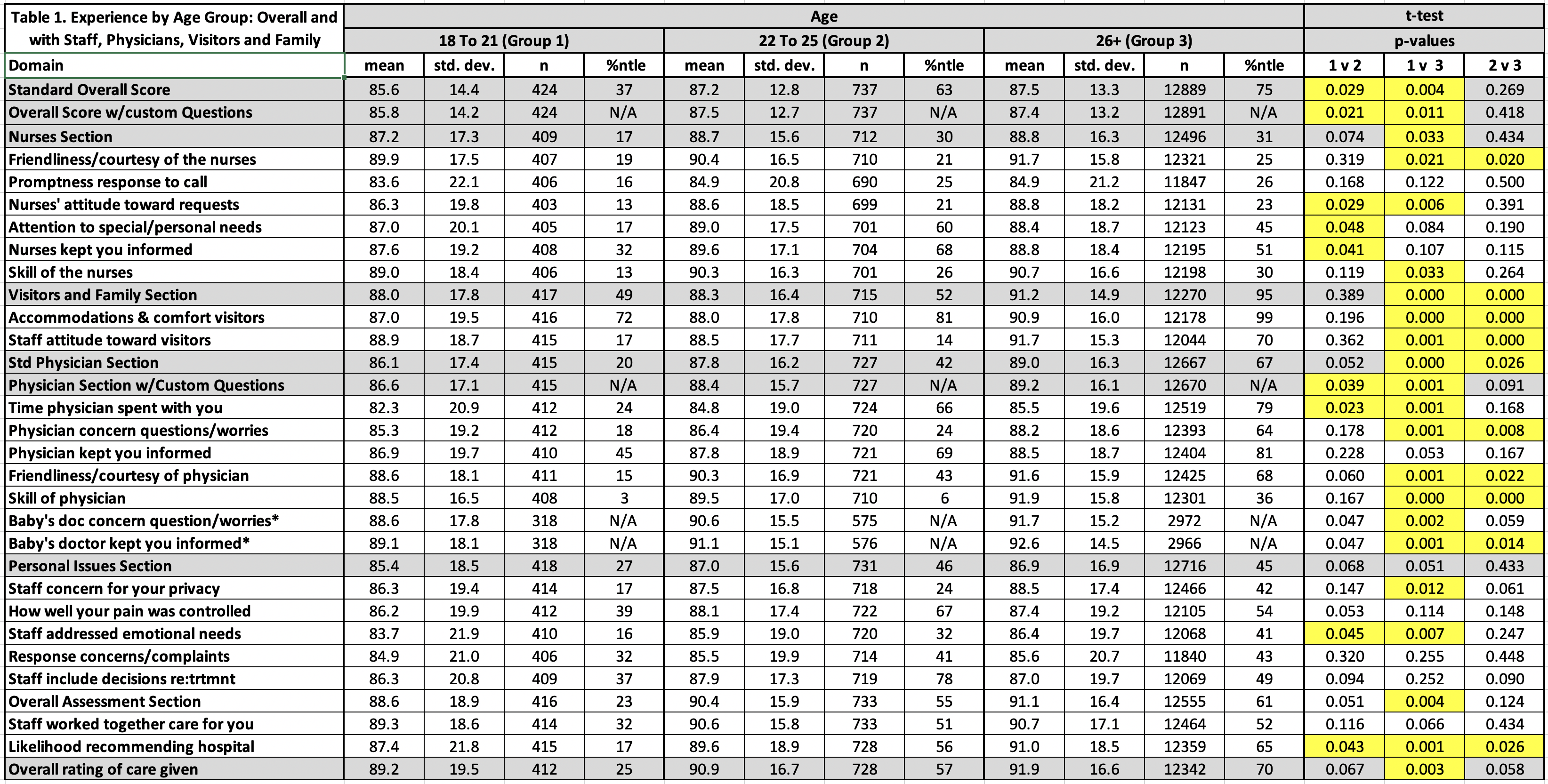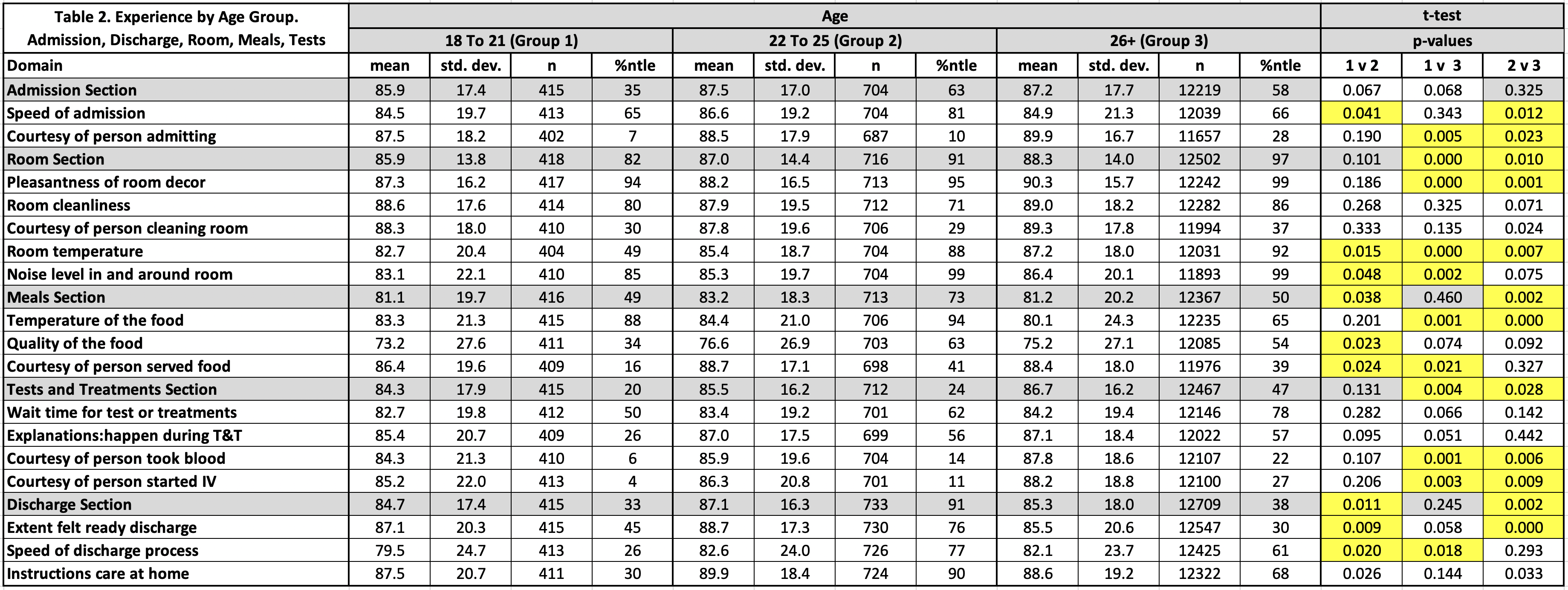Background: The transitioning from pediatric to adult care has been correlated with worsened outcomes including increased mortality [1]. Improving patient experience (PEX) has been correlated to improved adherence and lower inpatient mortality rates [2] as well as lower 30-day readmission rates for patients with heart failure, acute MI and pneumonia [3]. Young adults transiting from children’s specific healthcare facilities to adult hospitals encounter a drastically different environment, culture and processes of care. Accordingly, young adults may experience care differently than other hospitalized adults.
Methods: We performed a retrospective cohort study of patients admitted between October 1, 2015 and September 30, 2019 to Parkland Memorial Hospital, a 862 bed academic safety net hospital in Dallas, TX. We compared all domains of PEX between patients aged 18-21 years (group 1), 22-25 years (group 2) and 26+ years (group 3). We used a two tailed t-test to compare group 1 with group 2, group 1 with group 3 and group 2 with group 3. A p-value of <0.05 was considered significant.
Results: In the four-year study, we had 424 PEX surveys from group 1, 737 surveys from group 2 and 12,889 surveys from group 3. The overall PEX rating was worse for group 1 (85.6, 37th percentile) when compared to both group 2 (87.2, 63rd percentile, p=0.029) and group 3 (87.5, 75th percentile, p=0.004) (Table 1). Young adults’ experience with their nurses and physicians was also worse than older adults. Group 1 gave a worse overall rating to their nurses than group 3 (87.2, 17th percentile v 88.8, 31st percentile, p=0.02). Group 1 also felt their nurses’ attitude towards their requests was worse than group 2 and 3’s experience (86.3, 13th percentile v 88.6, 21st percentile and 88.8, 23rd percentile, p= 0.029 and 0.006). Regarding their experience with their physicians, group 1 and 2’s overall experience was worse than group 3’s (86.1, 20th percentile and 87.8, 42nd percentile v 89.0, 67th percentile, p<0.001 and 0.026). In the three physician domains: answered your questions and addressed your concerns, friendliness and courtesy and perceived skill; both groups 1 and 2 had a worse experience and perception than group 3 (p<0.05 for each domain). Groups 1 and 2 also had a markedly worse perception of their family and visitors’ experience, rating overall experience, accommodation and comfort and staff attitudes all worse than Group 3 (p< 0.001 for all domains). Group 1’s scoring of staff attitudes toward visitors translated to the 17th percentile as compared to the 14th percentile for group 2 and the 70th percentile for group 3.Our young adults also had a worse experience with the environment and processes of care than their older counterparts (Table 2). Groups 1 and 2 both rated their satisfaction with their rooms lower than group 3 (85.9, 82nd percentile and 87.0, 91st percentile v 88.3, 97th percentile, p<0.001 for both comparisons). Groups 1 and 2 also rated the courtesy of the admissions staff, phlebotomist and personnel placing IVs as worse than group 3 (all p-values <0.05).
Conclusions: Transitioning from a children’s facility into an adult hospital is a vulnerable time. Our study suggests a substantial difference in patient experience for young adults aged 18-21; and, to a lesser extent, aged 22-25, as compared to adults aged 26 and older. The domains of worsened experience are numerous, spanning relationships with their care providers to physical environment and processes of care; and profound, with a 38 percentile difference in overall experience.


